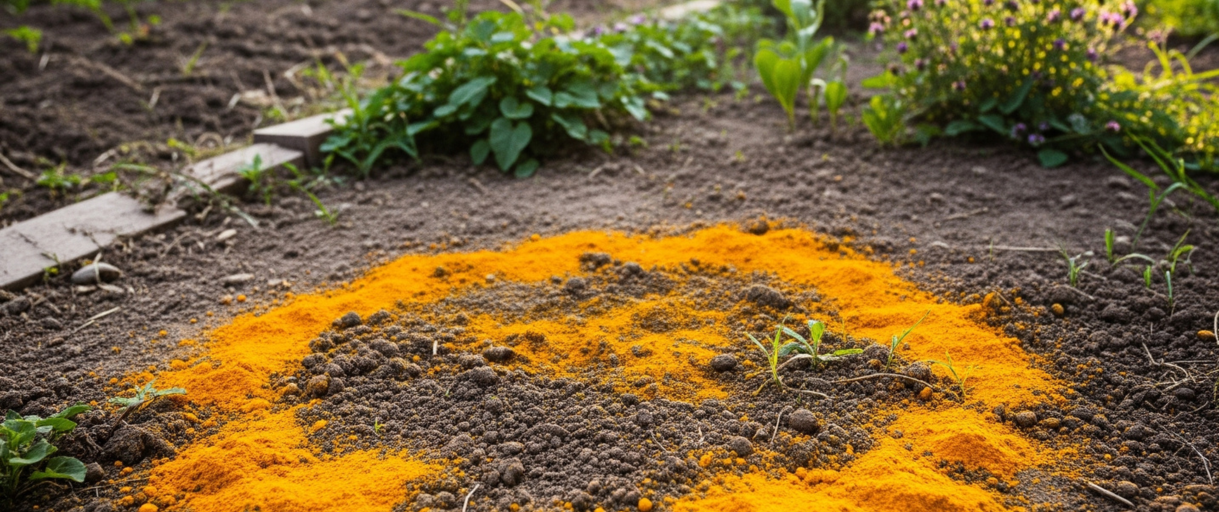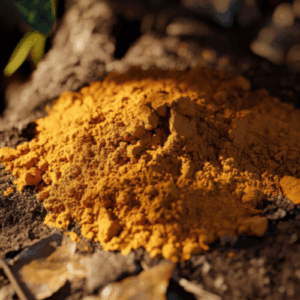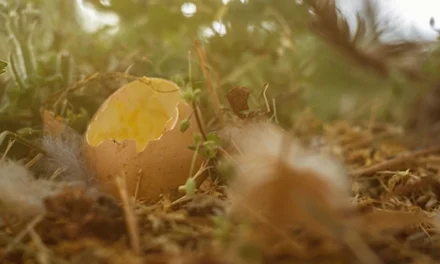Synthetic pesticides drain budgets and harm soil. Turmeric flips the script. After replacing neem oil with a turmeric-diatomaceous earth mix, my aphid infestations dropped by 80%.
Curcumin, its active compound, strengthens plant cells against drought and disease. My zucchini survived 90°F weeks with weekly turmeric sprays.
At $0.10 per application, it’s cheaper than vinegar solutions. I’ve even phased out rooting hormone using turmeric-honey paste. Why buy six products when one spice does it all?
Why Turmeric?
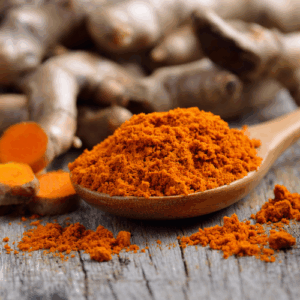
Homesteaders seeking natural garden remedies often overlook turmeric powder, but its science-backed perks make it a stealthy soil ally.
Curcumin, turmeric’s active compound, doesn’t just color your curry. It annihilates fungal cell membranes.
Turmeric’s antioxidants, like curcuminoids, also arm plants against stress. Think of them as tiny shields, bolstering immunity against diseases and drought.
But here’s the kicker: turmeric subtly nudges soil pH toward acidity. Blueberries, which demand a pH of 4.5–5.5, thrived in my beds after I sprinkled a tablespoon of turmeric around their bases monthly.
Don’t ignore your compost pile. Mixing turmeric with coffee grounds – a trick I learned from a fellow homesteader – ignites microbial activity. The spices’ antimicrobial properties suppress pathogens while coffee’s nitrogen feeds decomposers. Try a teaspoon of turmeric per quart of grounds to turbocharge breakdown.
Fighting Fungal Infections Naturally
Turmeric’s anti-fungal properties work like a silent bodyguard for your plants. Curcumin, the compound that gives turmeric its punch, disrupts fungal cell walls on contact.
For root rot, mix a teaspoon of turmeric powder into the soil around affected plants. The spice stops the fungus from spreading while letting healthy roots recover.
Common garden fungi like damping-off disease hate turmeric.
For stubborn cases, brew a turbocharged compost tea: steep two crushed garlic cloves and a tablespoon of turmeric in a gallon of water overnight.
Strain it, then spray leaves and soil every three days until the infection clears. Garlic’s sulfur compounds team up with turmeric’s curcumin, creating a one-two punch that synthetic fungicides can’t match.
Turmeric as a Natural Pest Repellent
Turmeric’s sharp aroma and bioactive compounds like curcumin just annoy pests and scrambles their senses.
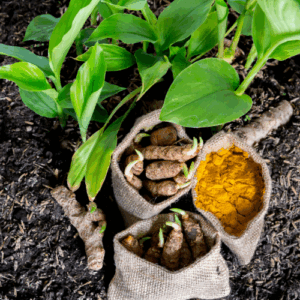
Aphids, ants, and even beetles avoid plants dusted with turmeric powder. Unlike synthetic pesticides, turmeric won’t harm earthworms or ladybugs, making it a homesteader’s stealth weapon for balanced ecosystems.
For a quick ant barrier, mix equal parts turmeric and diatomaceous earth. Sprinkle the blend around plant bases or along garden paths.
The turmeric confuses foraging ants, while diatomaceous earth dehydrates them. Reapply after heavy rain—this combo isn’t waterproof, but it’s cheaper and safer than chemical granules.
Turmeric also outshines store-bought sprays in cost and simplicity. A $5 jar of spice treats an entire garden for months, and you won’t need gloves or masks to apply it.
Just don’t drench plants – stick to light dusting. Overdoing it can temporarily stain stems yellow, but a quick hose rinse fixes that.
Turmeric isn’t the only plant that pulls double duty in the garden. Several medicinal herbs are just as valuable for their pest-repelling properties as they are for their healing uses. Growing them alongside your crops not only supports a more balanced ecosystem, but it also means fewer chemicals and fewer problems.
If you’re looking to add these kinds of plants to your garden, you can try out this Medicinal Garden Kit that makes it easy. It includes non-GMO, heirloom varieties like:
- California Poppy: Its strong scent can deter aphids and leafhoppers while attracting beneficial insects.
- Yarrow: Repels beetles and ants, while drawing in ladybugs and lacewings that feed on pests.
- Echinacea: It attracts pollinators and parasitic wasps that help keep pest populations in check.
- Calendula: Naturally deters nematodes and aphids and helps confuse whiteflies with its bright blooms.
- Chamomile: Deters mosquitoes and flies, and improves the health of neighboring plants.
- Marshmallow: Acts as a trap crop for pests like flea beetles, drawing them away from more vulnerable plants.
- Chicory: Its bitter compounds repel certain insects and it improves soil structure for plant health.
- Evening Primrose: Can deter some moth species and acts as a companion plant to reduce pest stress on nearby crops.
Planting a mix like this doesn’t just help repel pests. It strengthens your whole garden ecosystem, naturally.
Boosting Plant Health with Natural Nutrients
Healthy plants start with their roots, and turmeric gives them a fighting edge.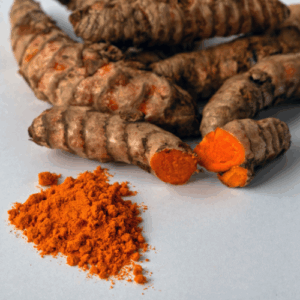
Curcumin doesn’t just fight fungi; it acts as a plant probiotic, feeding soil microbes that convert organic matter into nutrients.
These microbes, like Bacillus subtilis, thrive with turmeric and help plants absorb phosphorus and potassium more efficiently.
For a quick soil boost, mix 1 tsp turmeric and 1 tbsp molasses into a gallon of water. Molasses feeds the microbes, while turmeric kickstarts their activity.
Apply it every two weeks during peak growing season. Your plants will reward you with deeper roots and fewer disease flare-ups.
Turmeric also toughens plants against drought. The antioxidants shields cells from stress, much like how vitamin C protects your skin. Just avoid overdoing it: more than a tablespoon per gallon can temporarily slow growth in sensitive plants like beans.
This kind of steady, natural support pairs especially well with raised beds, where soil conditions are easier to control, and applications like turmeric can be targeted more precisely. Add a simple hoop house, and you’ve got a setup that stretches your growing season on both ends, shields crops from heavy rain or surprise frosts, and keeps pests at bay without needing constant sprays.
Raised beds warm up faster in spring, drain better after storms, and are easier on your back come harvest time. Combined with a hoop frame, they also make it simple to rotate covers.
Poor construction, however, can lead to drainage issues, bowing boards or frames that collapse under pressure. If you’re thinking of building your own, make sure you follow a good guide that shows exactly how to get the structure right, especially if you want it to last more than a season or two. Done properly, these beds can anchor your garden for years.
How to Use Turmeric in Your Garden
Turmeric works best when you match the method to the problem. For quick fixes, sprinkle it dry: dust a pinch directly onto soil around plants or lightly coat leaves to deter pests.
Dry application sticks better in calm morning air. I’ve found it lasts up to five days before rain washes it off. But for deeper issues like soil health or root rot, brew a turmeric tea.
Steep 1 tablespoon of turmeric in a gallon of hot water for two hours, let it cool, and water your plants. The infusion penetrates soil faster, reaching roots and microbes.
Combine turmeric with other natural remedies to amplify results. Mix it into compost tea for a microbial feast, or add a teaspoon to neem oil sprays for a pest-fighting double play.
We homesteaders thrive on experimentation. Track how your plants respond to different doses: try ½ tsp turmeric per gallon weekly for seedlings versus 1 tsp for established crops.
I log results in a garden journal, noting changes in growth speed or pest damage. Small tweaks can reveal big wins, like discovering that my carrots grew straighter with monthly turmeric soaks.
Creative Uses of Turmeric in Your Garden
Turmeric’s versatility stretches far beyond pest sprays and soil drenches. Protect fragile seedlings by misting them with a diluted turmeric solution, 1/4 tsp per quart of water.
The spray forms a protective film on the soil surface, blocking fungal spores without smothering tender roots.
But don’t stop at seedlings. Toss a handful of turmeric into your compost pile weekly. The spice accelerates breakdown while suppressing foul odors.
Another trick? Whip up a garden protectant by blending 1 tbsp turmeric, 2 cups water, 1 tsp apple cider vinegar, and a drop of castile soap.
Strain and spray it on squash vines or rose bushes to repel beetles and mildew. For propagating cuttings, skip commercial rooting hormones.
Dip stem ends in a paste of turmeric and raw honey (1:1 ratio) before planting. The honey’s enzymes and turmeric’s anti-pathogen properties encourage roots without chemicals.
From Soil to Self: Turmeric Isn’t Just for Plants
Turmeric might earn its place in the garden for fighting fungus and fending off pests, but its usefulness doesn’t end in the soil. For centuries, this bright yellow spice has been a staple in natural remedies, and it turns out many of the same properties that protect plants can support the gardener, too.
Curcumin, the powerhouse compound in turmeric, is well-known for its anti-inflammatory and antioxidant effects. After hours spent tending to beds or hauling compost, muscles and joints can pay the price. A simple remedy involves mixing a teaspoon of turmeric powder into warm milk, along with a pinch of black pepper and a bit of honey. The pepper increases the body’s absorption of curcumin, making the mixture more effective. Many gardeners turn to this blend to ease soreness and promote quicker recovery after a long day outdoors.
That turmeric-honey paste used on plant cuttings? It’s just as useful on minor scrapes, insect bites and small wounds. Applied to the skin, turmeric’s antimicrobial properties help reduce redness, swelling, and the risk of infection – an ideal option when working far from a medicine cabinet.
Turmeric also lends itself to a simple energy tonic. Steep one teaspoon of turmeric in hot water with a squeeze of lemon and a dash of cayenne or black pepper. It’s a popular homemade drink used to support immunity and gently boost stamina, especially during planting or harvesting season.

And that’s just the start of it. There are so many simple, really powerful ways to use turmeric at home. Each one is easy to make, and no special equipment or rare ingredients are needed.
🫚Young Heart Elixir: A warming blend designed to support circulation and cardiovascular health using turmeric and a few other familiar kitchen spices. A natural way to keep the heart strong without synthetic supplements.
🫚Anti-Inflammatory Root Infusion: Perfect after a long day of chores, this soothing mix helps ease joint stiffness and calm the kind of deep muscle fatigue every homesteader knows well.
🫚Antioxidant Vision Protection: Long hours in the sun and wind can take a toll on the eyes. This blend is crafted to support healthy vision and protect against everyday strain, using turmeric’s potent antioxidant compounds.
🫚Moon Milk for Better Sleep: A calming evening drink that helps the body unwind and transition into restful sleep. Gentle, natural, and a perfect ritual if you prefer not to rely on over-the-counter sleep aids.
These are just some of the 250 recipes that can be found inside The Forgotten Home Apothecary – the book where Dr. Nicole Apelian shares her decades-long knowledge of traditional healing and herbal remedies. This book offers you all the tools and wisdom you need to thrive, no matter the season.
And while turmeric supports the body from the inside out, it’s worth noting a few precautions: its deep golden pigment can stain fabrics, tools, and even skin. Use dark-colored gloves or utensils when handling it in the kitchen – or consider those yellow smudges a badge of good work.
Pro Tips & Mistakes to Avoid
Turmeric’s potency means moderation is key. I once dumped a tablespoon around my bean seeds, assuming “more is better,” and germination stalled for weeks.
High concentrations can inhibit growth—stick to ½ tsp per square foot of soil. For seedlings, a light dusting (think powdered sugar on a doughnut) is plenty.
If you’re mixing sprays, test them on a single leaf first. Stains are inevitable, but manageable. After turmeric-tinting my favorite gardening gloves permanently, I switched to disposable nitrile ones. For tools, wipe blades with vinegar immediately after use—it cuts through the pigment.
Wear dark-colored clothes. That neon-yellow handprint on my white shirt? Still a conversation starter at the farmers’ market.
Timing impacts results. Apply turmeric solutions early in the day so leaves dry fully before dusk, reducing mildew risks. Avoid midday sun—spraying in direct light can scorch treated foliage.
Sprinkle, Grow, Repeat
Grab that turmeric jar from the pantry. Mix a batch of soil booster punch, sprinkle some around your blueberries, or brew a compost tea.
Then observe.
Homesteading rewards the curious, and turmeric’s golden touch might just surprise you.
What Happens If You Drink Turmeric Lemonade Every Day (Video)
Why You Should Use Hot Pepper On Your Plants And Vegetables

